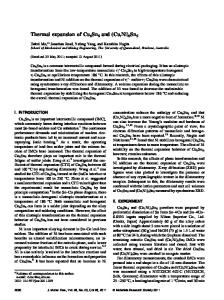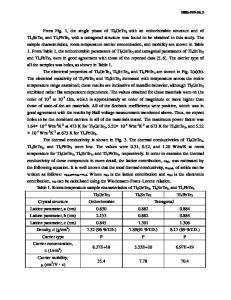Influence of Sn on the structural and thermoelectric properties of the type-I clathrates Ba 8 Cu 5 Si 6 Ge 35-x Sn x (0
- PDF / 306,782 Bytes
- 8 Pages / 432 x 648 pts Page_size
- 40 Downloads / 312 Views
Influence of Sn on the structural and thermoelectric properties of the type-I clathrates Ba8Cu5Si6Ge35-xSnx (0 x 0.6) X. Yan1, E. Bauer1, P. Rogl2, and S. Paschen1 1 Institute of Solid State Physics, Vienna University of Technology, Wiedner Hauptstr. 8–10, 1040 Vienna, Austria. 2 Institute of Physical Chemistry, University of Vienna, Währingerstr. 42, 1090 Vienna, Austria. ABSTRACT On the search for cost-competitive thermoelectric clathrates we have investigated the influence of Sn substitutions for Ge on the structural and thermoelectric properties of the type-I clathrate Ba8Cu5Si6Ge35. The solid solubility of Sn was found to be limited to 0.6 atoms per unit cell. A series of compounds with the nominal compositions Ba8Cu5Si6Ge35-xSnx (x = 0.2, 0.4, 0.6) was synthesized in a high-frequency furnace. The samples were annealed, and subsequently ball milled and hot pressed. The hot pressed samples were characterized by X-ray powder diffraction, energy-dispersive X-ray spectroscopy and transport property measurements. Our results show that the substitution of Ge by Sn introduces vacancies at the 6d site of the type-I clathrate structure and shifts the highest dimensionless thermoelectric figure of merit ZT from 570 °C for the Sn free sample to lower temperatures. The highest figure of merit ZT = 0.42 is reached at about 320 °C for the Sn-substituted sample Ba8Cu5Si6Ge35Sn0.6. INTRODUCTION Intermetallic type-I clathrates have been investigated extensively in recent years as promising thermoelectric materials [1,2]. Their superior thermoelectric performance is closely related to the crystal structure, which is comprised of two kinds of polyhedral cages and guest atoms encapsulated in them [3]. The weakly bonded guest atoms can rattle in the over-sized cages, resulting in intrinsic low lattice thermal conductivities due to strongly scattered heatcarrying phonons [1,2,4-6], reduced group velocities of acoustic phonons [7], and/or a phonon filtering effect [8]. Low thermal conductivity is a prerequisite for a high dimensionless thermoelectric figure of merit, which is defined by ZT = TS2 /(ρκ) , where T, S, ȡ, and ț are the absolute temperature, Seebeck coefficient, electrical resistivity, and thermal conductivity, respectively. Charge transport in clathrates is governed by the covalently bonded framework of the host atoms (cage atoms), giving rise to relatively high charge carrier mobilities. Binary type-I clathrates have a general formula A8E46, with A = alkali, alkaline, or rare-earth element, and E = group IV element. The stability of the crystal structure can be understood with the Zintl concept [9]: the valence electrons of the guest atoms A are transferred to the framework atoms E to fulfill their octet electronic configurations. Therefore, without vacancies in the structure, binary type-I clathrates could not be synthesized under normal pressure [10,11]. It has been found that the framework atoms E can be substituted by a wide variety of elements [12], e.g., transition metal and group III elements. The substitutio
Data Loading...











